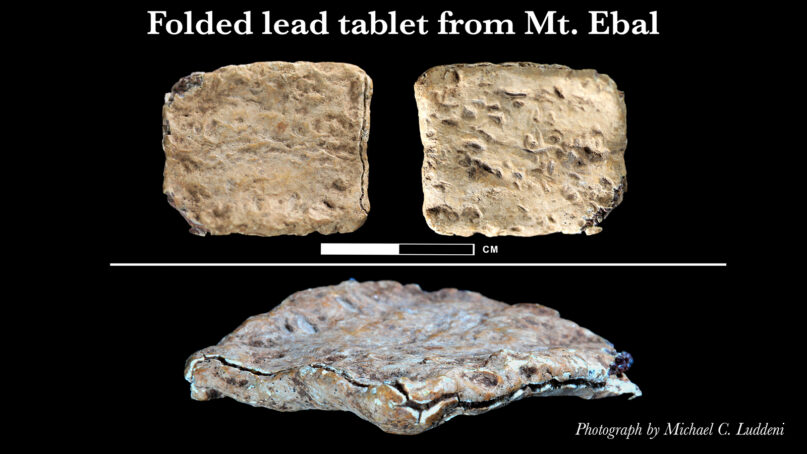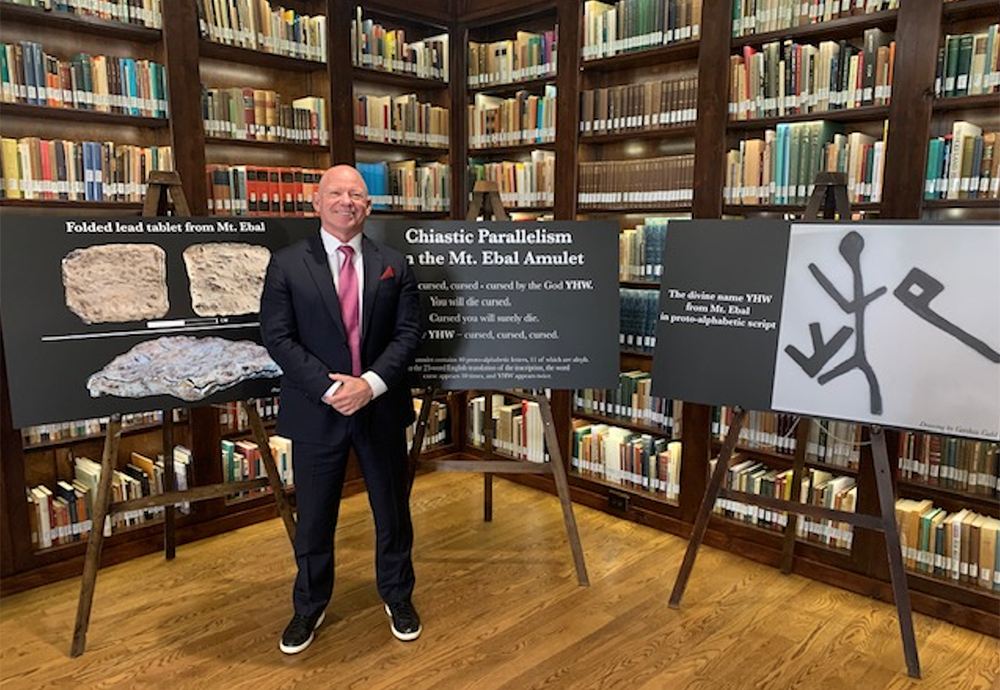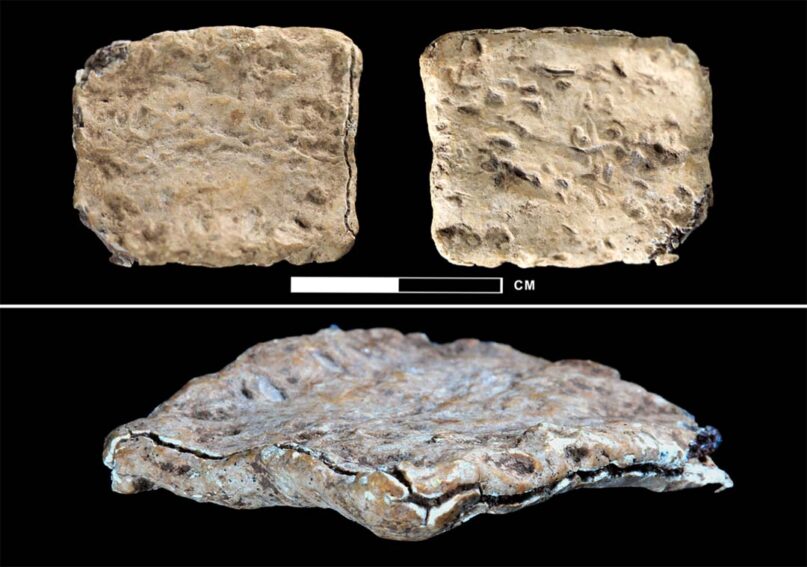Earliest mention of ‘Yahweh’ found in archaeological dump
The artifact, less than 1 inch in length and width, and known as a curse tablet, may spur renewed debate on the dating of biblical events, especially those told in the Book of Exodus.

(RNS) — An ancient tablet discovered near the Palestinian city of Nablus may contain the earliest known mention of God’s name in proto-alphabetic Hebrew.
Scott Stripling, director of the Archaeological Studies Institute at The Bible Seminary in Katy, Texas, announced the discovery of the lead tablet Thursday (March 24).
He said it could push back the written record of the name “Yahweh” a couple of centuries earlier, to at least 1200 B.C. and perhaps as early as 1400 B.C.
The finding may also spur renewed debate on the dating of biblical events, especially those told in the Book of Exodus. A peer-reviewed article is in process.
The artifact, less than 1 inch in length and width and known as a curse tablet, also recalls the account of Joshua building an altar nearby, which Israeli archaeologist Adam Zertal excavated in the 1980s.
The curse tablet was discovered near Mount Ebal, also called the Mount of the Curse in the books of Deuteronomy and Joshua. Stripling found it in a dump site, part of the structure Zertal identified as Joshua’s altar. Stripling said the finding was a confirmation of the biblical account.
In recent years, Stripling also announced the discovery of a Tabernacle platform during his ongoing excavations at biblical Shiloh.

Scott Stripling announces the discovery of an ancient lead tablet, March 24, 2022, in Houston. Photo by Jerry Pattengale
But the 2-centimeter-square (.78-inch) amulet may be the signature discovery of a lifetime. Professor Gershon Galil of the University of Haifa said this type of discovery is made only once a millennia.
Galil deciphered the hidden internal text with another paleographer, Pieter Gert van der Veen of the Johannes Gutenberg-Universität Mainz. A release from the Associates for Biblical Research press said they employed advanced tomographic scans to recover the hidden text.
The inscription reads: “Cursed, cursed, cursed — cursed by the God YHW. You will die cursed. Cursed you will surely die. Cursed by YHW – cursed, cursed, cursed.”
Stripling was joined by Museum of the Bible CEO Harry Hargrave, who noted, “This little artifact helps us understand better the history, story, and impact of the Bible — all within one square inch.”
Gabriel Barkay had helped Stripling learn the wet-sifting technique in Jerusalem’s Temple Mount. Barkay made the remarkable discovery in 1979 of the Ketef Hinnom scrolls, which contain the earliest biblical text discovered (circa seventh century B.C.).
The Mount Ebal tablet’s text provides context outside the biblical canon but sheds light on the historical context six centuries earlier.
“Our discovery of a Late Bronze Age inscription stunned me,” Stripling said.
The dirt around the area of the discovery was discarded over 30 years ago. It had been dry-sifted before Stripling’s decision to run it through again using the wet-sifting technique.
Ancient curse inscription deciphered from tablet discovered during archaeological wet sift on Mt. Ebal
Biscuit Media Group

High-tech scans reveal ancient Hebrew script, centuries older than any
other known tablets.
HOUSTON — Today, the Associates for Biblical Research (ABR) announced the discovery of a formulaic curse recovered on a small, folded lead tablet. The defixio came to light in December 2019 when archaeologist Scott Stripling, Director of the Archaeological Studies Institute at The Bible Seminary in Katy, Texas, led an ABR team to wet sift the discarded material from Adam Zertal’s excavations (1982–1989) on Mt. Ebal.
The ancient Hebrew inscription consists of 40 letters and is centuries older than any known Hebrew inscription from ancient Israel. Stripling formed a collaboration with four scientists from the Academy of Sciences of the Czech Republic and two epigraphers (specialists in deciphering ancient texts): Pieter Gert van der Veen of Johannes Gutenberg-Universität Mainz and Gershon Galil of the University of Haifa. The scientists employed advanced tomographic scans to recover the hidden text. In collaboration with Stripling, Galil and van der Veen deciphered the proto-alphabetic inscription, which reads as follows:
Cursed, cursed, cursed – cursed by the God YHW.
You will die cursed.
Cursed you will surely die.
Cursed by YHW – cursed, cursed, cursed.
THE LAW OF 3 (THREE) IN THIS CASE "CURSED" IS SAID THREE TIMES BY THREE TIMES MAKING NINE, THE ACTUAL POWER OF THE AMULET REGARDLESS OF THE GODS NAME OR APPLICATION (WHICH IS ONLY TWICE) EP
According to Stripling, “These types of amulets are well known in the Hellenistic and Roman periods, but Zertal’s excavated pottery dated to the Iron Age I and Late Bronze Age, so logically the tablet derived from one of these earlier periods. Even so, our discovery of a Late Bronze Age inscription stunned me.”
Almost immediately Galil recognized the formulaic literary structure of the inscription: “From the symmetry, I could tell that it was written as a chiastic parallelism.” Reading the concealed letters proved tedious, according to van der Veen, “but each day we recovered new letters and words written in a very ancient script.”
Daniel Vavrik and his colleagues from Prague ensured the accuracy of the raw data which the team interpreted. According to Deuteronomy 27 and Joshua 8, Mt. Ebal was the mountain of the curse. Joshua 8:30 indicates that Joshua built an altar on Mt. Ebal. The defixio derived from previously excavated and discarded material from a structure Zertal believed was Joshua’s altar.
An academic, peer-reviewed article is in process and will be published later in 2022. The collaborative team consists of Scott Stripling, Gershon Galil, Ivana Kumpova, Jaroslav Valach, Pieter Gert van der Veen, Daniel Vavrik, and Michal Vopalensky.
For more information, media should contact the collaborative partners as follows:
Czech – Daniel Vavrik (vavtik@itam.cas.cz)
English – Scott Stripling (scott.stripling@thebibleseminary.edu)
German – Pieter Gert van der Veen (pvanderv@uni-mainz.de)
Hebrew – Gershon Galil (ggalil@univ.haifa.ac.il)
Spanish – Scott Stripling (scott.stripling@thebibleseminary.edu)
Biscuit Media Group
biscuitmediagroup.com
Disclaimer: The views and opinions expressed in this article are those of the authors and do not necessarily reflect the official policy or position of Religion News Service or Religion News Foundation.
No comments:
Post a Comment